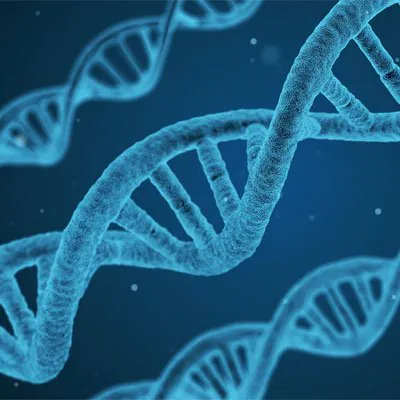The Applied Biosystems GeneChip system (formerly Affymetrix GeneChip) supports both DNA and RNA analysis and offers crucial added value for numerous applications.
Molecular genetic studies are often carried out with the help of so-called gene or biochips. The modern systems enable the parallel analysis of several hundred thousand individual proofs using the smallest blood or tissue samples. The Applied Biosystems GeneChip technology is a proven method to quickly generate large amounts of data and to obtain valuable starting points for further investigations.

Since 2009, Dr. Anna Henger is responsible for gene expression and genotyping at Biolytix. The chemist has been involved in working with the GeneChip system from the start. As an expert in gene expression analysis, she provides answers to basic questions about microarrays in an interview and explains why Applied Biosystems not only offers important added value for medicine and research. Microarrays are also used in genome analysis and diagnostics. Not only human samples can be analyzed with them. They are used in many studies involving animals, plants or pathogens.
What is the rationale behind Applied Biosystems GeneChip technology?
The Applied Biosystems GeneChip system is a commercial microarray platform. There are different forms of microarrays, which – as with Applied Biosystems – are also referred to as gene chips or biochips. Like a computer chip, they contain a lot of information in a small space. Using the microarray method, specific genes can be identified and their activity measured. In molecular biology we speak of gene expression analysis. For example, we can show how cells respond to a specific treatment.
In gene expression analysis, the focus is on gene products as well as “splice” variants. In this context, statements about gene regulation are possible. This gives us an overview of cellular functions. For example, different tissues, tissues of different developmental stages, normal and pathological tissues, or treated and untreated cells can be compared.
What are the key benefits of Applied Biosystems GeneChips?
The Applied Biosystems Arrays can be used on both the RNA and DNA levels for samples from different species – that means for humans, animals, plants or pathogens. Although different kits are required for sample preparation, the procedure is basically very similar. And: all microarrays can be processed with the same apparatus. With the Applied Biosystems Arrays, we can generate large amounts of data that allow statements to be made about the entire genome in order to elucidate complex mechanisms underlying biological processes or diseases.
In which areas is the Applied Biosystems GeneChip technology used?
GeneChips have a wide range of applications – from drug research and pharmaceutical studies to clinical research at universities and diagnostics.
As already mentioned, a large area of application is gene expression analysis to determine induced or repressed genes, which provides an overview of cellular functions.
In the diagnosis of genetic diseases, the Applied Biosystems GeneChip can identify even small deviations in the gene sequence when genomes from patients are compared with samples from healthy people. Other areas of application are toxicological analyzes or the validation of drug targets for certain drugs.
GeneChips are also used in agricultural genomics or agrigenomics. Using this technology, relevant genetic markers for economically important species (animals, plants, etc.) can be easily identified and thus cultivation and breeding decisions can be made.
Why are the Applied Biosystems GeneChips so important for personalized medicine?
In the field of gene expression analysis, the data provide insight into the expression level of the entire transcriptome and enable the identification of RNA biomarkers, splice variants, pathways (signal transduction pathways) and gene regulation https://assets.thermofisher.com/TFS-Assets/LSG/brochures/gene-expression-microarrays-assays-brochure.pdf. In toxicogenomics, the GeneChips are used to investigate gene expression patterns and their changes as a result of therapeutic or environmental influences.
In genetic diagnostics, the samples are analyzed for single nucleotide exchanges (SNPs) and copy number variations (CNVs). In genome-wide association studies (GWAS) on large collectives of patients and test persons, DNA variants can be identified in the entire genome that are associated with diseases on the basis of statistical analyses. After further clarifications, this can be the approach for the therapeutic application of individualized medicine. Patients can therefore receive a therapy that is suitable for them more quickly and the healthcare system becomes more efficient.
What can microarrays technology do better than other molecular genetic methods?
With the microarrays, we quickly obtain a large amount of data from the smallest sample material – and thus different approaches or an overview of what is happening in the entire genome and transcriptome. With the help of further procedures, it is then necessary to filter, analyze and verify them. There are specific microarrays for different questions. In addition, the technology has been on the market for more than two decades. So there are numerous databases that researchers can access and exchange ideas with.
As a special laboratory, what added value does Biolytix offer its customers with regard to GeneChip technology?
GeneChip technology is a tried and tested system. The arrays have been steadily improved and updated over the last twenty years. Biolytix as a company has been working with the technology since its inception and has seen its progress. That means: We know the development, the updates and, above all, the possibilities that the Applied Biosystems GeneChip process offers. As a specialized laboratory, we at Biolytix can and have examined smaller samples as well as several hundred samples – such as in larger clinical studies. We generate the data in our laboratory and, after quality control, hand over the raw data to the customer.
Can the customer evaluate the data received himself?
There is now user-friendly software for initial analysis. For example, for gene expression analysis, the Transcriptome Analysis Console (TAC) software provides a fast, easy solution to analyze and visualize global expression patterns of genes and signal transduction pathways, as well as exons and splice variants. But of course the tools are only applicable to a certain extent. They provide a good overview. In order to go deeper, the know-how of a biotechnician or bioinformatician is required, who starts with additional tools and the corresponding experience and goes deeper.
Are there comparable methods that could compete with microarrays in the future?
A possible competing product could be Next-Generation Sequencing (NGS). This is a new type of nucleic acid analysis technology. However, I don’t necessarily want to see NGS and microarrays as competition because the methods are fundamentally different. Statements about the entire genome and for all species are also possible here. In contrast to other sequencing methods, several hundred million fragments can be sequenced in one sample. The NGS technology is used, for example, to identify relevant genes – among other things for the early detection of tumor diseases.
NGS can also shed light on new regions in the genome, additional differentially expressed genes, and signal transduction pathways. But much of the additional data would not be relevant to the statement in many studies. So unlike NGS, with microarrays only the region of the genome that is represented in the individual samples can be analyzed.
Nevertheless, microarrays offer some advantages: In terms of size, microarray data are easier to handle than NGS datasets. The huge amounts of data from next-generation sequencing can be an advantage, depending on the question. At the same time, they can also pose a challenge even for simple studies due to the amount of data, because the software development is not yet advanced enough to ensure automatic evaluation.
A large number of microarray-based studies have been performed in the last two decades. Standards have been introduced that allow the quality of the data to be assessed. These datasets, supplemented by public databases such as GEO and Array Express or DrugMatrix, have created easily accessible and analyzable databases that serve as an important reference for new analyzes and interpretations of the data.
In contrast, no such reference databases are available for NGS data, which currently limits the interpretation of the data. There is a clear need to build these databases to make better use of microarray data, to facilitate the interpretation of NGS data, and to allow seamless translation and comparison of NGS and microarray data.
Ultimately, both methods have their justification and are used depending on the question. But: The Applied Biosystems GeneChip technology currently simply offers a stable, continuously updated construct from two decades of research and development.




